Something for Everyone at the 7. Todd-AO 70mm Festival at the Schauburg Filmtheater |
Read more at in70mm.com The 70mm Newsletter |
| Written by: Brian Guckian (Ireland) | Date: 26.10.2011 |
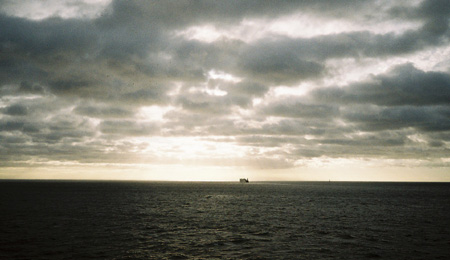 Crossing
the Irish Sea by ferry. Image by Brian Guckian Crossing
the Irish Sea by ferry. Image by Brian GuckianIt truly was “Something for Everyone” at this year’s event, which keeps on getting better and better. Having attended the Second Festival back in 2006, I was privileged to be able to return this year, for a very enjoyable and indeed educational weekend of 70mm spectaculars. I decided to travel in suitably “epic” fashion this time, overland and almost completely by train. This involved crossing the Irish Sea by ferry to Wales, then travelling to London in order to take the Eurostar service via the Channel Tunnel to Paris, followed by a direct TGV connection from Paris to Karlsruhe via Strasbourg. A total distance by rail of about 1430 km / 890 miles – but one would never know it, such is the comfort and convenience of European high-speed rail travel today. En route I was able to meet up with my good friend and colleague Mike Taylor in the historic Roman town of Chester, where we enjoyed a traditional English pub lunch. As the cinema industry “transitions” to digital video we talked about Projectionist friends and acquaintances who had recently been made redundant or have taken early retirement. Thankfully, 70mm lives on! London is now only two hours from Chester, thanks to Virgin Trains and their impressive tilting Super Voyager trains. Also, nothing beats arriving in the very heart of cities of course, as opposed to having to travel in from an airport. Overnighting in the busy metropolis (and the only criticism I would have is that accommodation anywhere in central London is very expensive) the gothic splendour of the magnificently-restored St. Pancras Station awaited next morning. This was a really impressive experience, with passengers introduced to the spectacular single-span Barlow trainshed and its platforms via a spacious departure lounge situated in the vast undercroft of the station. Since the completion in 2007 of the HS1 high-speed line from London to the Channel Tunnel, the journey time from London St. Pancras to Paris Gare du Nord is now just 2 hours 20 minutes. On arrival at Gare du Nord after an incredibly smooth journey, it was more or less straight to the equally-impressive Gare de l’Est where a TGV awaited for Stuttgart, which would pass through Strasbourg, and then Karlsruhe, en route. After a chance to practice my somewhat rusty French on the hapless denizens of La Ville-Lumière / The City of Light, it was time for the 3-hour high-speed journey across the Champagne-Ardenne, Lorraine and Alsace regions via the LGV Est, which at present is open as far as Baudrecourt (near Nancy and Metz) and is due for completion to Strasbourg in 2014. Showing how high-speed rail transforms journey times, what was once a 4-hour journey from Paris to Strasbourg is now just 2 hours 20 minutes, and this will fall even further to 1 hour 50 minutes when the LGV Est is completed. |
More in 70mm reading: Todd-AO Festival Home • 7. Todd-AO Festival • Wilkommen | Welcome • Intro | Festival Images • 2011 Festival Flyer (PDF) Festival Archives • Festival Through the Years • Festival Schedule and Archive • More Schauburg Cinerama Festivals in Pictures • Schauburg Cinerama • Best of Todd-AO Festival • Guests | Billboards | Posters 65/70mm Workshop Internet link: • Schauburg.de |
|
| |
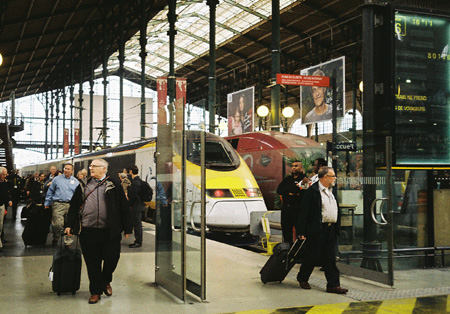 Arrival
at Gare du Nord. Image by Brian Guckian Arrival
at Gare du Nord. Image by Brian GuckianKarlsruhe is a relatively short distance up the Rhine Valley from Strasbourg, and arriving at the Hauptbahnhof on Thursday evening, I made my way to my hotel, which was located just a few minutes from the cinema. Rather embarrassingly, having been able to travel the best part of 900 miles / 1440 km, I couldn’t find Brauerei Wolf where our esteemed Editor had kindly arranged to meet me! However we were subsequently able to rendezvous at the Renaissance Hotel, so all was not lost. The Festival got off to a fine start on Friday morning with 1966 Russian epic "Bela" (Geroy Nashego Vremeni, also known as A Hero of Our Time), which via the Sovscope 70 process made full use of the stunning mountain scenery of the Northern Caucasus to weave its tale of romance-amid-conflict. This was a highly-accomplished exercise in large-scale storytelling, as anti-hero army officer Pechorin (Vladimir Ivashov) pursues the beautiful and enigmatic Circassian Princess of the title (Silvia Berova) against the backdrop of the Caucasian War. A surprise for me was the pacing, which never flagged throughout, being almost contemporary in style. This was also a truly international screening, being in Russian with Czech subtitles, and additional German subtitles digitally superimposed by the Schauburg’s technical team! After the break it was time for an even bigger epic, George Stevens’ "The Greatest Story Ever Told", filmed in Ultra Panavision 70. I have to say that I have a fondness for Biblical Epics (and enjoyed a previous screening in Bradford UK of John Huston’s "The Bible", filmed in Dimension 150). One might dub this film The Greatest Cast Ever Hired, such was the sheer number of well-known actors from the period taking part, and in another feat of cinematic authenticity, missing scenes from the print were very effectively inserted digitally by the Projectionists (even matching the faded colours), so that the running time was restored to the 197 minute version. One theme that emerged across the films shown over the weekend was the various Directors’ mastery of large screen / wide format filmmaking, often using relatively simple visual techniques to achieve a big impact. For example, one of the most effective and powerful scenes in "The Greatest Story Ever Told" is the resurrection of Lazarus, filmed almost entirely in long shot so that when he appears at the entrance to his tomb, high up on a hillside, the effect is very disturbing, clearly inviting the audience to share the same point of view as the local people portrayed on screen watching the event. Another striking feature of the film was its very effective use of traditional matte paintings, often seamlessly integrated into the action via excellent optical compositing work. |
|
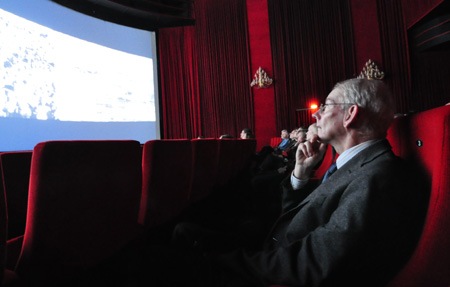 Kevin
Brownlow's lecture was completed by the last reel of "Napoleon" in 70mm on
the curved screen. Mr. Brownlow is looking at the screen from the 5th row.
Image by Thomas Hauerslev Kevin
Brownlow's lecture was completed by the last reel of "Napoleon" in 70mm on
the curved screen. Mr. Brownlow is looking at the screen from the 5th row.
Image by Thomas HauerslevA highlight of this year’s Festival took place on Friday evening. This was a Lecture given by the eminent film historian, archivist and preservationist Kevin Brownlow entitled From Biograph to Fox Grandeur: Early Experiments in Large Format Presentations. This was a fascinating and detailed account of the use of wide-gauge film in Early Cinema, with 75mm and 68mm in existence around 1900, and the era of patent wars and rivalries among various key figures such as Thomas Edison and WKL Dickson vividly brought to life. Mr. Brownlow described the Polyvision triptych process used by Abel Gance in "Napoleon" and recounted his own, extraordinary and fateful meeting with Gance, which led to his career in Cinema. Also discussed were the 63mm Natural Vision (1926), 65mm Fox Grandeur (1930) and 65mm Magnifilm (1931) processes, proving as always that there’s nothing new in motion pictures! The Lecture concluded with an impressive screening of the triptych section from "Napoleon", via a 70mm print, which reminded one how sophisticated Gance was in advancing cinematic techniques in the service of story-telling. It is to be hoped that this Lecture may become available to students of Cinema, perhaps in the form of a published Paper. The evening concluded with a very entertaining screening of "The Bat Whispers", which was shown on 35mm but still very sharp of course given its 65mm origination. With its deliberately hammy performances and elaborate mise-en-scene this was a treat from start to finish, including the regulation twist ending and subsequent on-screen entreaty not to reveal it to others! Long before the likes of "Airplane", this was a send-up to be savoured. The next morning began with the now-traditional and very welcome Frühstückbuffet provided by Herbert Born and his dedicated staff. It should be said that the provision of refreshments throughout the weekend, avoiding the need to leave the cinema, is a major selling-point of the Festival, allowing people to relax, converse and not worry about having to rush back to make the next screening. Blake Edwards’ "Missouri" (aka "Wild Rovers") was an entertaining and off-beat anti-Western, which looked very good from a 35mm blow-up (colour fading aside). This was one of several examples over the weekend where the 70mm format again proved itself indispensable for large screen presentations, with much more even illumination, steadiness and definition compared to straight 35mm projection (the Schauburg’s screen measures about 50 feet / 15.25m across the chord). Although more associated with comedic fare, Edwards showed a deft handling of the Western genre in this picture, with engaging performances from William Holden and Ryan O’Neal and interesting early turns by Joe Don Baker and Tom Skerritt. The film also featured an appropriate score from the versatile and much-missed composer Jerry Goldsmith. 1971 was a turning point in Hollywood, so perhaps the pairing of Holden and O’Neal could be said to reflect “Old Hollywood” giving way to the New. |
|
|
"Sheherazade" (1963) was a rarely-seen French
production, filmed in the
MCS Superpanorama 70 format, and reputedly made
with a budget of 10 million francs. This appeared to be only loosely
inspired by the One Thousand and One Nights tales of Arabic literature and
seemed to have much more in common with Hollywood’s "Arabian Nights" picture
of 1942. Set in the year 809 AD, the plot revolves around Villecroix (Gérard
Barray), a knight of Charlemagne sent by the emperor as an emissary to the
caliph of Baghdad. Encountering the beautiful Sheherazade (Anna Karina),
their subsequent love affair invokes the jealousy of the caliph, who
condemns her to death. I found it a little bit tedious, but the boredom was
relieved by the succession of on-screen beauties - always a winning formula
when your film is in trouble! The 65mm format was ideal for capturing the
impressive expanses of the Morocco desert locations, as well as the details
of the intricate and elaborate set design. After Kaffee & Kuchen it was a time for a complete change of scene with the second screening this year of Joe Massot’s "Dance Craze" (1981). Now here was a film that really rocked, taking full advantage of the 70mm 6-track format, and it was also a relief to see something in full colour! This was a completely immersive concert film experience, brilliantly shot and edited, and pre-dating extravaganzas like "Stop Making Sense" and "Rolling Stones: At the Max". The film skilfully captured the rebellious energy of Ska, whilst humourously counterpointing this with footage from staid British information and newsreel films about “the youth of today”. It was amazing to see bands like Bad Manners, Madness and The Beat perform classics like Mirror in the Bathroom and One Step Beyond in a suitably “in yer face” fashion, which the big screen made possible. And, this was a superior blow-up print, being made directly from the original negative, which itself had a larger area than usual (35mm Super 1.66 format – 30% larger than regular 35mm 1.66). This is a film that deserves wider appreciation - and more screenings! |
|
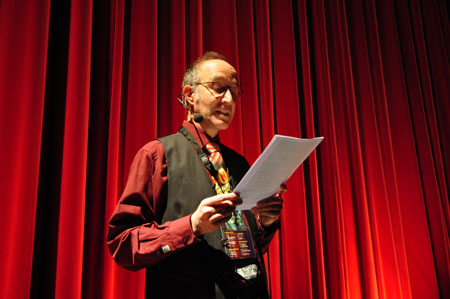 Wolfram
Hannemann introducing the films. Image by Thomas Hauerslev Wolfram
Hannemann introducing the films. Image by Thomas HauerslevIf one wished to see what the 65/70mm format is truly capable of, one needed look no further than Saturday evening’s Gala Presentation of Kenneth Branagh’s "Hamlet" in Super Panavision 70. The ultra-faithful and visually-spectacular adaptation of Shakespeare’s meisterwerk simply gets better and better with every viewing, with new details in both the play and its staging revealed every time. The phrase that came to mind watching the film was, “It doesn’t get any better than this” and it again underscores the value and potential – even now – of this Rolls-Royce of cinema formats. "Hamlet" is an extraordinary achievement on so many levels – acting, direction, cinematography, set design, costume design, to name a few – and is among a select number of films that can only be fully appreciated on 70mm. It was also interesting that the digital effects were mostly invisible - proving it was possible to carry off digital VFX shots on 65mm even in 1996. The presentation took full advantage of the Schauburg DP70’s new 7KW lamp, with Technician Gunter Oehme telling me they had raised the illumination level significantly above normal, and it showed – the “gold standard”, as another afficionado commented. Sunday morning took us to the world of Broadway Theatre with a screening of Richard Attenborough’s 1985 adaptation of "A Chorus Line"; as with "Dance Craze", this was an excellent blow-up from a Super-35 negative and another early example of the use of this format. The film turned out to be better than I expected, the potentially restrictive theatrical setting successfully overcome by Ronnie Taylor BSC’s creative cinematography, with excellent pacing by Editor John Bloom and memorable musical number “One” by Marvin Hamlisch. Another surprise was the unexpected hard edge to the story, which undermined any stereotyped “luvvie” preconceptions one might have about the theatrical world. This doesn’t seem to have impressed the critics however, as reviews were mixed on release. "55 Days in Peking" was a reminder, like "Sheherazade", that in the 1960s European producers were able to mount large-scale productions shot in wide-gauge / widescreen film formats, and the film industry was far more international in nature at that time. Perhaps today only someone like Luc Besson might be able to rise to such a task, and the late German producer Bernd Eichinger also comes to mind. I have to say I didn’t take to this Samuel Bronston production, perhaps due to a lack of realism (it was shot in Spain). The Super Technirama photography was indifferent in my view, and certainly not half as good as 65mm origination would have been. Consequently I didn’t return for the second half – maybe it got better then! The five Canadian educational short films – "A Place to Stand", "Multiple Man", "Seasons in the Mind", "Where the North Begins" and "Festival" displayed many innovative techniques for their time, including very elegant and sophisticated use of multi-panel imaging somewhat reminiscent of traditional A/V multiple slide projector / tape presentations. Canada of course has a distinguished record in the field of creative documentary production, and "Multiple Man", with its non-narrative structure and wordless depiction of the diversity of humanity, could perhaps be viewed as a forerunner of "Baraka". Although "A Place to Stand", "Seasons in the Mind" and "Festival" are very much the product of a particular time and place, promoting the city and region of Ontario, there are compelling artistic and archival reasons to restore and re-print some, if not all these titles, and though new 70mm prints of regular commercial feature films can be hindered by rights problems and other issues, this should not be such a problem here. Certainly full appreciation of these works was lost due to colour fading; perhaps a reissue in DDE-70 format could be considered, especially as the films are short, and only work on the big screen. |
|
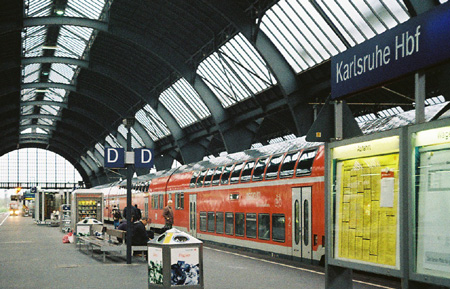 Departure
from Karlsruhe. Image by Brian Guckian Departure
from Karlsruhe. Image by Brian Guckian"Kelly’s Heroes" (1970), a blow-up from 35mm Panavision, ended the festival on a high note, and I found it of interest that this wartime caper was written by the late Troy Kennedy Martin, gifted writer of "The Italian Job", and classic British TV series "Z-Cars", "Reilly Ace of Spies" and "Edge of Darkness". Accompanied by a funky Lalo Schifrin soundtrack, and tongue-in-cheek song “Burning Bridges” by The Mike Curb Congregation, the film’s mix of action and comedy, with hippy overtones, was just the right way to end the weekend. Thanks to the great dedication of Herbert Born and his technical staff, the presentation during the weekend was faultless, with superb Showmanship / Präsentationstechniken, including perfectly-timed music, lighting and curtain cues throughout. The sound was also remarkable, all 70mm prints being presented in 6-track magnetic sound, with very clean reproduction and the trademark full range associated with magnetic soundtracks. With its Super Cinerama curved screen and top-rate sound and picture quality, the Filmtheater Schauburg certainly makes for an ideal 70mm Studio Theatre, and appropriately a special presentation was made to Herbert Born by the Swedish delegation at the end of the weekend as a mark of their appreciation. This year’s event drew visitors from all over Europe, including from the KRRR! 70mm filmfestival in Krnov, Czech Republic, and Austria, Switzerland, Sweden, The Netherlands and the UK, as well as further afield from the US. Complementing the always fascinating information given by Wolfram Hannemann in his introductions, attendees also received a comprehensive souvenir programme with additional expert articles and interviews, emphasising how this is as much an educational event as it is an entertaining one, and a must for anyone who is serious about Cinema. Many thanks again to everyone involved - Auf bald im nächsten Jahr! |
|
| Go: back - top - back issues - news index Updated 21-01-24 |
